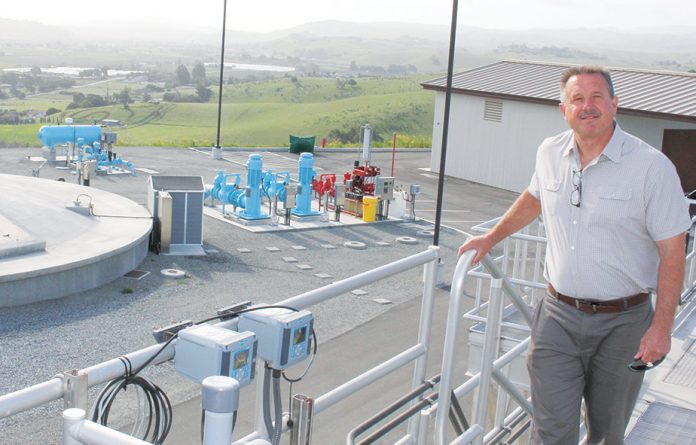When the new $25 million water treatment plant in southwest Hollister went online last August, expectations were high, for improved water quality for thousands of Hollister homes.
Don Ridenhour, general manager for the Sunnyslope Water District, which runs the new West Side water treatment plant, said the new plant is exceeding expectations.
The state-of-the-art facility on a hilltop overlooking the city contributes water to the interconnected system of treatment plants, pipes and pumping stations to serve Hollister and its growing neighborhoods.
The water treatment plant was financed by the San Benito Water District, and represents a partnership between the Sunnyslope Water District—which serves southern communities of Ridgemark, Quail Hollow and Fairview Road—the county district, and the City of Hollister Water Department, with loans repaid by fees paid by water consumers and connection fees paid by developers and new homeowners.
The new water treatment plant uses compressed air, sand, activated carbon and several chemicals to provide drinking water that is cleaner and “softer” than residents had a year ago, RIdenhour said.
He said Hollister residents will not need expensive water softeners if they have higher quality water with fewer minerals. In addition, the city is under pressure from federal water quality regulators to reduce the amount of salt the end up in groundwater. Much of this salt contamination comes from water softeners, he said.
The new treatment plant is distributing water to about 4,000 households in western and central Hollister.
Further expansion planned for this summer plays an important role in the renovations at San Benito High School.
The county Board of Supervisors was expected this week to give the final green light to construction of a new pipeline along the route of a new county road that officials hope will complete a bypass of Nash Road. This will allow the San Benito High School District to close Nash Road during school months, and enable the high school to use it as a pedestrian-only walkway in the middle of a massive campus renovation project.
The goal is to have the new pipeline and new road completed by the end of the summer, before the opening of the new school year in the fall.
Ridenhour said the pipeline also will allow the new West Side plant to begin serving the 1,500 homes in its “home” Sunnyslope Water District to the southeast.
“It’s one big system,” said Ridenhour.
In a tour of the new plant this week, he pointed to extra space, extra fittings and room for additional pipes and ponds, allowing for expansion in 10 years as the city grows.
The city’s integrated water systems uses a combination of local wells, and surface water purchased from the federal/state water system that brings water from the Sierras to San Benito and San Clara counties.
The new water plant, although highly automated, did create three new jobs, Ridenhour said.
The new water treatment plan treats about 4.5 million gallons per day. The Lessalt Treatment plant, a Sunnyslope District facility east of the city, treats about 2.5 million gallons per day.
The West Side plant could be expanded to treat up to 9 million gallons per day.
Ridenhour said that water conservation patterns implemented by businesses and homeowners during the 2012-2015 drought have continued, and water consumption in the region is lower than it was 10 years ago, despite the growth in housing and population.










